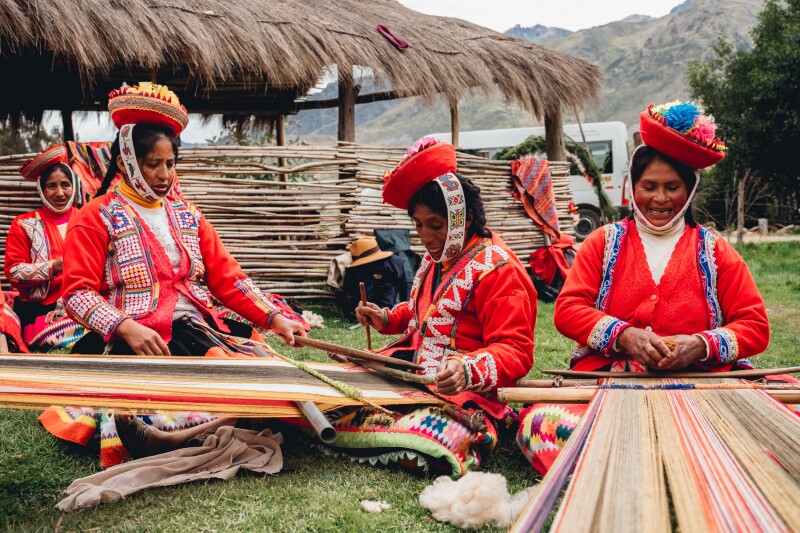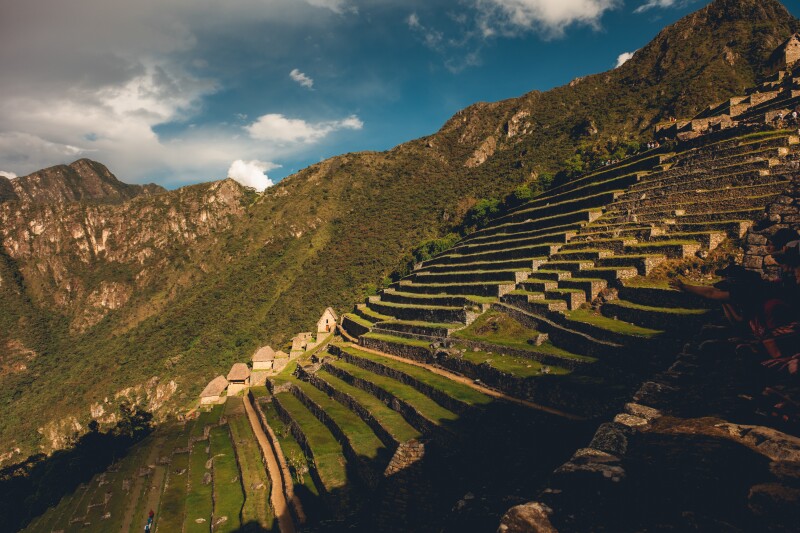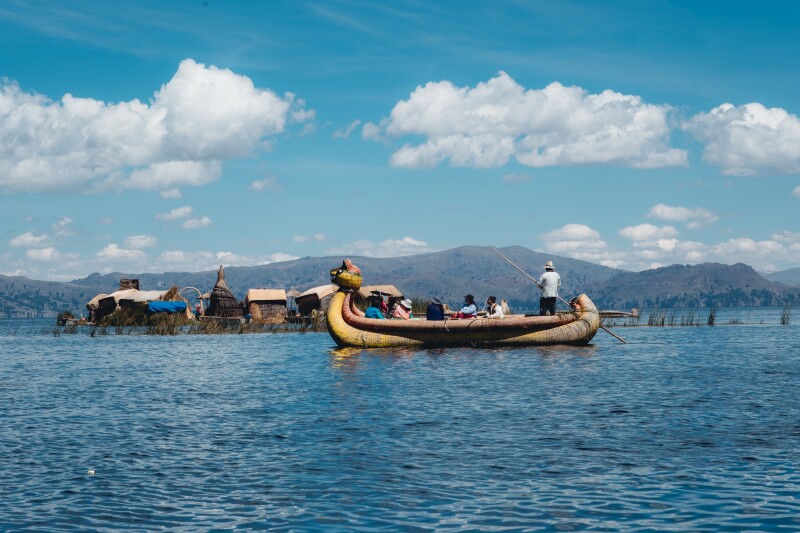World-class food. Surfable beaches and biodiverse rainforests. Stupendous mountains and some of the most famous ruins in the world. Incan history, Indigenous traditions, sand dunes you can sled down, and enormous geoglyphic drawings. There are countless reasons why Peru is so popular but also many ways to enjoy the country without the crowds. With a little planning, you can take two steps sideways from the tourist trail and enjoy everything this South American wonder has to offer while alleviating overtourism and giving a little back. Here’s how.

The Raqchi Incan site features the remains of a temple and dozens of circular warehouse buildings a few hours from Cusco.
Photo by Ryan Bolton
Do Machu Picchu right
Peru’s mountaintop icon has long been a poster child for overtourism, and despite recent measures to limit visitation, travelers still have to deal with, well, other travelers at this sacred space. However, you can witness the Incan masterpiece’s grandeur without feeling too jostled.
Machu Picchu has been split into different circuits since 2017, and in summer 2024 the Ministry of Culture expanded that to 10 different routes organized into three sections (panoramic, classic, and royalty) offering various ways to see all the sights and views. The Ministry of Culture’s Machu Picchu booking site lists every option, with maps and videos. (This clip, in Spanish, gives a good example of Circuit 1, Route 1A.)
The most popular options are the ones that get you higher up the mountain for that quintessential Instagram view of the entire site. However, on my visit in April 2024, I preferred taking a lower circuit for several reasons: It’s less vertiginous for those with a fear of heights, easier to navigate with physical disabilities, and crucially walked by far fewer people. You still pass many of the main sights, but you’re not part of a herd. Early mornings are also busy; everyone wants to see the sunrise, but if it’s a misty, foggy day (as it was on my visit), you’ll miss it anyway.
Consider also how you get there. The traditional Inca Trail is rightly popular and a once-in-a-lifetime challenge for many—you can plainly see that on the faces of those who spent three days trekking to complete it—but consider the Quarry Trail instead. This alternative route offered by Intrepid is one night shorter, features a waterfall (Perolniyoc Cascade) that the main trail doesn’t, and passes the famous IntiPunku sun gate. It might just be you, the guide, and the porter on this one.
Mountain Lodges of Peru also offers a seven-day Salkantay Trek that hits several less-visited sites and includes overnight accommodation in comfortable lodges. “There were more than 20,000 miles of Inca Trail (or Qhapaq Ñan) spread out all over South America during the Inca civilization,” the company’s CEO and cofounder Enrique Umbert told me. “The traditional Inca Trail is only a 26-mile stretch of this amazing network.”

Intrepid takes travelers to meet members of the Huilloc Alto community, who demonstrate traditional weaving techniques using llama wool.
Photo by Ryan Bolton
Get to know Machu Picchu’s neighbors
Incidentally, while thousands of people visit Machu Picchu each day, only 5 percent of the people who live in Peru’s highlands have made the trip, according to Intrepid. Earlier this year, it took a group of women from the Huilloc Alto community to the site, an experience which they said helped them feel “connected to their ancestors.”
Intrepid offers plenty of ways to meet local people in less-visited parts of the region. In addition to visiting some of the Huilloc Alto women in their homes via the Intrepid Foundation’s partner Amawaki, the tour operator’s itineraries often stop at the K’intuy De Ocutuan center. Here, members of the local community serve tea, share stories and ask questions, dance (requiring participation), and demonstrate their handiwork—cleaning and coloring alpaca wool using natural dyes before weaving them with llama bones.

Ama Sacred Valley comprises a boutique, restaurant, and tourism operator that describes itself as a “triple impact organization” that provides training and jobs to vulnerable populations in the Sacred Valley.
Photo by Ryan Bolton
Another essential stop is Ama Enterprise in Urubamba in the Sacred Valley, a shop and restaurant that works with vulnerable women and single mothers in the region, offering their crafts for sale and providing employment (and first-rate coffee and cakes to guests) in a peaceful courtyard.
Our host there, Julio Chemi Sanchez Hernandez, has worked tirelessly for local rights and opportunities throughout the pandemic years and beyond. He’s a firm believer in the power of tourism to make change, telling us that “the world needs more intrepid travelers. . . . With a simple brownie, you’re making history.”

Machu Picchu is a sprawling site; quiet corners are available.
Photo by Ryan Bolton
Explore other ruins in Peru
Peru is home to dozens and dozens of archaeological sites and points of pre-Hispanic interest, and it’s possible to spend a crowd-free day in many of them. If you pass through the Sacred Valley, you’ll likely stop in the village of Ollantaytambo, where the train departs for Machu Picchu.
The main archaeological site of the same name here is perched dramatically on a cliff ledge and popular for good reason. But a few minutes’ walk away, down an unmarked street and behind a school soccer stadium, I saw some small wooden signs pointing to another spot. Here the train toots died in the distance, birdsong and rushing water replaced tuk-tuk engines, and I found Qelloragay. The terraces here are free, open 24 hours, and it was only me and a cow on a Saturday at 5 p.m.
Just north of Cusco, meanwhile, the ruins of Saqsaywaman are huge and have spectacular views of the city. They were very sparsely attended on a Sunday morning, full of shady places to sit and reflect on the achievements of the short-lived civilization. The zigzag walls here mark the teeth of a puma, whose head makes up the whole site. Cusco itself comprises the body, as envisioned by the ninth Inca, Pachacutec.
They’re the first in a series of sites stretching up the hill among grassy plains used as picnic and play areas for local families, including Q’enqo, Pukapukara, and finally Tambomachay. The whole loop can be explored on a lengthy, hilly hike out of the city without a guide. I visited several—and explored another, the Temple of the Moon, which I approached by a deserted track through a peaceful valley. Here, locals lay in the grass sketching and napping like you might see in Central or Hyde Park. Foreign visitors were nowhere to be seen.

Cusco is South America’s oldest continuously inhabited city and a bustling place at the best of times. Climb the steep streets to nearby ruins, though, and you’ll find plenty of solitude.
Photo by Ryan Bolton
Take more time in Cusco
Cusco can feel like a touristy town, with all the honking hatchbacks and golden human statues you might expect in, say, Covent Garden. But you don’t have to venture far from the people posing with llamas to find everyday life. Follow the sloping Incan stonework, which laces the streets along with some fine water channels for irrigation, to the local food market (always a good place to head in a city), Mercado Central de San Pedro. Here, people start their day with a bowl of lamb’s head soup or fruit juice before work alongside tea sellers, butchers, and seafood stalls. Alternatively, among the city’s narrow streets, tiny coffee shops-cum-boutiques like Indie Café and Concept Store will fuel you for a day of exploration.
Many people head to the cathedral in the main square to see Marcos Zapata’s famous rendition of the Last Supper with a guinea pig on the table, but when I stepped into the nearby and far quieter Museo del Palacio Arzobispal, the cries of the massage hawkers and traffic died down, and I was surrounded by another collection of artworks from the 16th–18th century Cusco School. The only sound was the squeak of my footsteps on the varnished parquet floor and electric lights turned on as I entered each room.
Look for Lima’s lesser-known treats
As the main entry point for most visitors to Peru, Lima is perhaps the biggest marker on the country’s tourist trail. A global spotlight shines on the acclaimed Central, named best restaurant in the world in 2023 thanks to chef Virgilio Martínez Véliz working wonders with Indigenous fruits and a variety of domestic root vegetables. But there are ways to find flavor away from the crowds here, too—for starters, by eschewing Central in favor of easier-to-get-into Merito (from Central alumni Juan Luis Martinez).
I joined an Intrepid group city tour with guide Ali Jei, and she shuttled us to the best hole-in-the-wall joints of the back streets of the capital, filling us up with beef heart skewers, bao buns, churros (which look almost like a squashed croissant here), and pumpkin doughnuts with honey. Often we skipped past a line of people waiting for a treat they’d seen on Instagram to another establishment with the same sort of food but no crowd. Jei’s tour was part of Intrepid’s Quarry Trail itinerary.

For a view of Lake Titicaca without the hordes, consider an overnight train.
Photo by Ryan Bolton
Dive into the Amazon—and beyond
Afar deputy editor Katherine LaGrave traveled to Peru for a friend’s wedding in the spring. “Taking her advice, I headed to her favorite part of the country—the Peruvian Amazon,” she says. “I flew to the northern airport of Iquitos, took a two-hour car ride, and then a one-and-a-half-hour boat ride to reach the lodge I was staying at: Libertad Jungle Lodge on the Ucayali River, the headwater of the Amazon.
“Each day I chose from a list of excursions, including jungle hikes to learn about medicinal plants and waking up at sunrise to see the pink dolphins. Even though this was more remote than I had ever been—and with no Wi-Fi and a few hours of electricity a day—I felt very thankful to be able to experience a wilder side of the world.”
Katherine also spent a night on the Belmond Andean Explorer train, which afforded her a view of Lake Titicaca (no stranger to visitors) at dawn with no one else around. Tour operator Tierra Latina also offers a trip to the region that includes two nights with a local family on Amantani Island.
Ali Jei from Intrepid, meanwhile, has traveled to 22 of the 24 departments in the country, often backpacking and staying with rural communities that work in tourism. She’s found several lesser-known favorites and recommends the Gocta waterfall—which was off the radar of even the Peruvian government until 2005 but is one of the tallest in the world—near the community of San Pablo de Valera in the north. Local people there are farmers but have become aware of the “beautiful touristic factor” of their home, she says. Jei also recommends seeking out geysers in the country’s south near the city of Moquegua, an area that’s “not really visited by travelers from other countries.”
I noticed a slogan for the popular Inca Kola emblazoned on a wall in Lima on my final night: “Hagamos un Perú que nos dé gusto,” or “Let’s make a Peru that gives us pleasure.” It’s a campaign celebrating the country’s diversity and range of perspectives—something that travelers can easily tap into when they detour from the well-trodden path.











